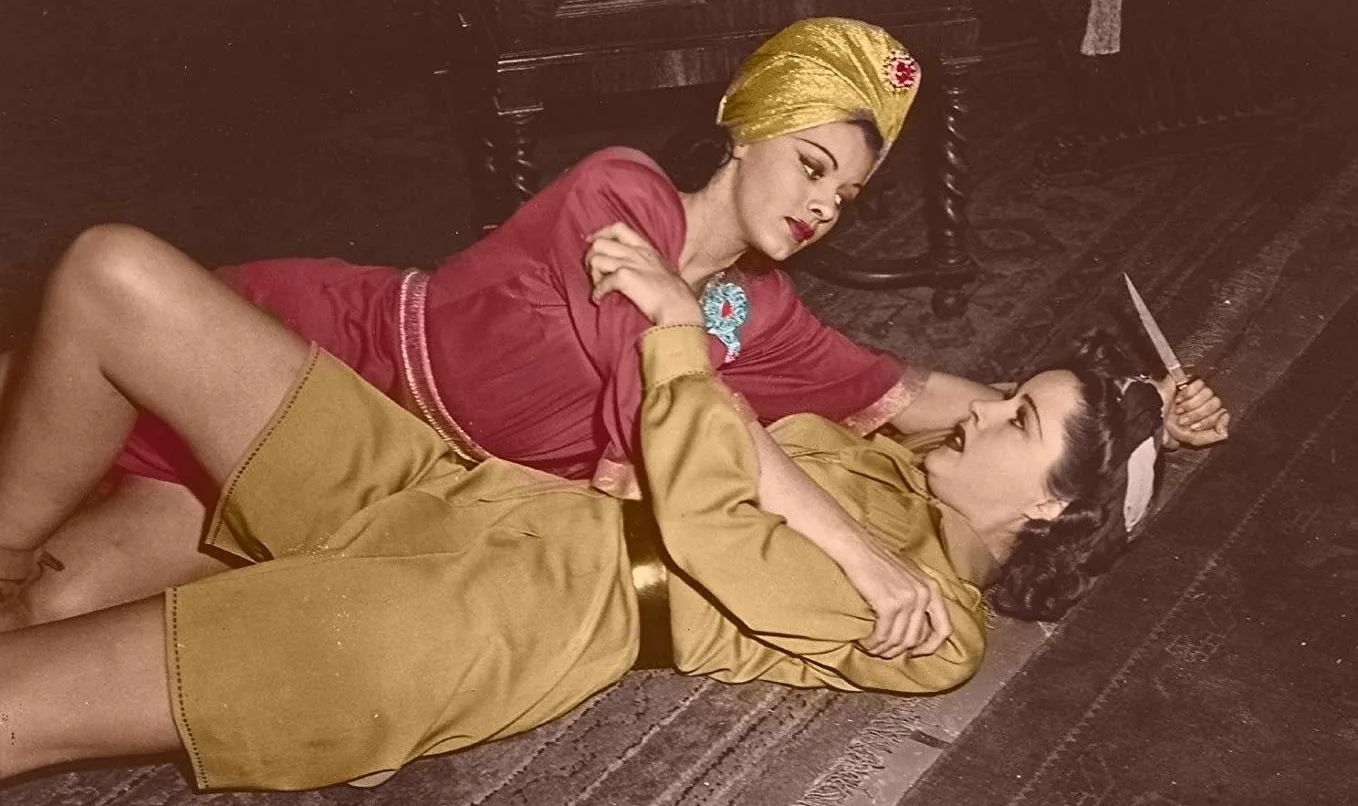 We’ve previously written about the first action heroines, such as Pearl White, who achieved fame through the cinematic serial of the silent era. I quoted the Los Angeles Times as saying in 1936, “There are no more serial queens.” While perhaps true, in the sense of actresses who not longer would take on their own dangerous stunts, action heroines did continue to be portrayed in serials, in a stronger way than usually found in ‘proper’ features of the time.
We’ve previously written about the first action heroines, such as Pearl White, who achieved fame through the cinematic serial of the silent era. I quoted the Los Angeles Times as saying in 1936, “There are no more serial queens.” While perhaps true, in the sense of actresses who not longer would take on their own dangerous stunts, action heroines did continue to be portrayed in serials, in a stronger way than usually found in ‘proper’ features of the time.
These reached their peak from 1936 to 1945, a period known as the golden age of the serial, and were part of the entertainment package offered by the cinema at that time. Rather than just seeing a movie, you’d get a whole night’s worth of entertainment. This could include a newsreel, a cartoon, a double-bill of features (hence the term “B movie” for the second, typically cheaper film) and, often a serial. It was a single story told like a modern TV show in an episode per week, typically over 12-15 installments. There would be a cliffhanger ending on each part, encouraging viewers to come back next week and see how the hero/ine escaped certain doom.
This structure lent itself particularly to certain genres: Westerns, crime and science-fiction entries were all common. As well as the bigger studios like Universal and Columbia, serial specialists like Republic sprang up to fill the need for product. Initially an amalgamation of several smaller companies in financial trouble, Republic were in operation for over thirty years, from 1935 through 1967. In addition to their serials, they made B movies, again particularly concentrating in the Western and crime genres, and helped launch the careers of stars including John Wayne and Gene Autry. Though Republic also distributed Orson Welles’s Macbeth in 1948.
Their serials came from varying sources. While some were original, others were based on existing properties: they adapted comic strips (Dick Tracy), pulp novels (Zorro) and even radio shows (The Lone Ranger). In 1941, they made Adventures of Captain Marvel, the first superhero film/serial based on a comic. In a typical year, they’d put out three or four serials, with budgets in the first half of the forties typically around $150,000 per entry. Directors like William Whitney, Spencer Gordon Bennett and Fred C. Brannon were responsible for many of these; Quentin Tarantino called Whitney, “the best Western director in American film history”. [When the Bride and Bill are talking in Kill Bill Volume 2, the film on TV is Whitney’s The Golden Stallion]
 But for the purposes of this site, Republic leaned heavily into the “jungle girl” trope. This was a popular way of stepping around the mores of polite society, allowing the portrayal of female characters less fettered by the standards of civilized society. It’s an archetype likely founded in H. Rider Haggard’s She, where the immortal Ayesha ruled her isolated subjects. Another early example is the 1904 novel Green Mansions by William Henry Hudson, the story of jungle girl Rima, who falls in love with a Venezuelan traveller. It was later made into a 1959 movie starring… um, Audrey Hepburn and Anthony Perkins. Yes, Eliza Doolittle and Norman Bates. It was not a success. Unsurprisingly, Edgar Rice Burroughs got in on the act: the fourth novel in his signature franchise, The Son of Tarzan, introduces an example of the character in Meriem.
But for the purposes of this site, Republic leaned heavily into the “jungle girl” trope. This was a popular way of stepping around the mores of polite society, allowing the portrayal of female characters less fettered by the standards of civilized society. It’s an archetype likely founded in H. Rider Haggard’s She, where the immortal Ayesha ruled her isolated subjects. Another early example is the 1904 novel Green Mansions by William Henry Hudson, the story of jungle girl Rima, who falls in love with a Venezuelan traveller. It was later made into a 1959 movie starring… um, Audrey Hepburn and Anthony Perkins. Yes, Eliza Doolittle and Norman Bates. It was not a success. Unsurprisingly, Edgar Rice Burroughs got in on the act: the fourth novel in his signature franchise, The Son of Tarzan, introduces an example of the character in Meriem.
Up until the fifties, when the crackdown on salacious content effectively killed them off for decades, there were also a slew of comics depicting jungle girls. In some cases, they were the “other halves” of heroes, such as Jano who was the mate of Voodah (an actual African couple). But some were, or became, independent characters in their own right. Sheena, Queen of the Jungle is perhaps the best known: she debuted as far back as 1937, and had her own title from 1942 on, becoming the first female comic-book character to do so. The success of Sheena begat any number of imitators, such as Camilla, Wild Girl of the Congo or Judy of the Jungle.
Early live-action examples include features The Savage Girl (1932), Inyaah, Jungle Goddess (1934) and The Jungle Princess (1936), the last of which helped make Dorothy Lamour a star. However, as with the serials, the character in question was still white in most cases, ending up in the wilderness, either through accident or choice. Among the series we’ll be covering, Vultura, the villainess in Perils of Nyoka, is a rare example of a genuine “native”. Though as the quotes indicate, any such authenticity is mostly theoretical – her perfectly tweezed eyebrows do not exactly suggest a life spent outside the borders of civilization.
I want to mention the stuntwomen who worked on these, who rarely received credit – indeed, men often stood-in for actresses. They include Babe DeFreest, who was the only stuntwoman on Zorro’s Black Whip, But the main one used by Republic seems to be Helen Thurston, who got her start doubling for Katherine Hepburn in 1938’s Bringing Up Baby. The following year, according to her grand-niece, Thurston appeared in The Wizard of Oz, playing the Cowardly Lion when he jumped through a window – a very rare case of a stuntwoman doubling for a man. She stood in for Marlene Dietrich in the famous Destry Rides Again catfight, and did most of the doubling (save for the vine-swinging) in Jungle Girl for Frances Gifford. Thurston would go on to double Marilyn Monroe in River of No Return, and was still doing stunts into the sixties, including on Mary Poppins!
Starting today and for the next few weeks, each Monday we’ll have a new review, covering one of the Republic serials which was heroine-centric. That will go all the way through to 1955’s Panther Girl of the Congo, one of the last the studio put out. Perhaps the time is ripe for a revival of this format. With their short duration and cliff-hanger, episodic structure, they seem tailor-made for the limited attention span of the modern consumer. On the other hand, anyone remember Quibi? Exactly…
Jungle Girl
By Jim McLennan★★½
“You can take the girl out of the jungle…”
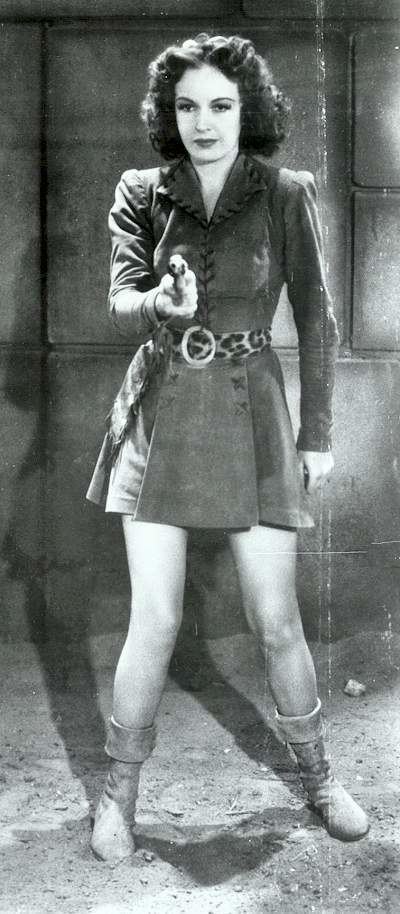 This is nominally based on Edgar Rice Burroughs’s 1932 novel of the same name, also known as The Land of Hidden Men. Though there’s very little beyond the title in common. The book was set in Cambodia, and told the story of explorer Gordon King, who finds a civilization which has been lost for a thousand years. This… isn’t. It is instead the story of Nyoka Meredith (Gifford), the daughter of a doctor working with the Masamba tribe in the middle of Africa. “Nyoka” is Swahili for snake, and she seems to spend most of her free time swinging through the forest on vines.
This is nominally based on Edgar Rice Burroughs’s 1932 novel of the same name, also known as The Land of Hidden Men. Though there’s very little beyond the title in common. The book was set in Cambodia, and told the story of explorer Gordon King, who finds a civilization which has been lost for a thousand years. This… isn’t. It is instead the story of Nyoka Meredith (Gifford), the daughter of a doctor working with the Masamba tribe in the middle of Africa. “Nyoka” is Swahili for snake, and she seems to spend most of her free time swinging through the forest on vines.
But there’s trouble in paradise, as ne’er-do-wells Slick Latimer (Mohr) and Bradley Meredith (Bardette) show up, hoping to get their hands on the tribe’s stash of diamonds. Their plan involves Dr. Meredith’s twin brother, who just got out of jail. They knock off the doctor, replacing him with his sibling, who feigns “amnesia” to explain the holes in his memory. They also team up with disgruntled witch-doctor Shamba, who was displaced from his tribal position by Western medicine. But Nyoka, along with Jack Stanton (Neal) and Curly Rogers, stand in the way of the villains. Though naturally, they will have narrowly to dodge death – I’m guessing, fourteen times, give or take.
While this was the first serial in the sound era to have a female lead, it’s a little disappointing in this regard. It feels like, over the course of the 15 episodes, Nyoka is more rescued than rescuing, though it does work both ways. In terms of getting into the action, there’s more than one occasion where she just yells “Look out!”, then lets the menfolk get on with punching each other. However, Nyoka still has her moments, such as in Episode 5, where she dives into a gorge and goes hand-to-hand with a crocodile, in order to save a native child. I did appreciate the lack of any romance here. Despite the obvious candidacy of Jack, everyone is too busy narrowly dodging those deaths, I think, for emotional entanglements.
Considerably less progressive is the portrayal of the natives. I guess we should be happy Shamba is at least played by a non-American, Frank Lackteen being Lebanese-born. But the native boy saved from the crocodile? Born in Minnesota (the actor, Tommy Cook, was still active almost eighty years later, playing a senator in an episode of Space Force!). Even aside from the blackface, add patronising lines like “It took a white man to figure it out,” and there are a lot of elements which have not aged well, to put it mildly. Some of the plot threads are also a bit implausible, such as Jack and Curly building an impromptu refinery in the native village, to convert crude oil into airplane fuel. I’m fairly sure it’s not that easy.
One of the stunt co-ordinators on this was the legendary Yakima Canutt. He would go on to choreograph the chariot race in Ben-Hur, though there’s none of his renowned equine stuntwork here. Helen Thurston was the main double for Gifford, though for the scenes where she’s swinging from vine to vine, a male stuntman (David Sharpe) took over. Apparently, Gifford said he looked better in the costume than she did! The series was so successful it became the first Republic serial to be re-released, six years later. A lot of the action footage from this was reworked into 1955’s Panther Girl of the Kongo, but we’ll talk more about that in its own review.
Dir: William Witney and John English
Star: Frances Gifford, Tom Neal, Trevor Bardette, Gerald Mohr
Perils of Nyoka
By Jim McLennan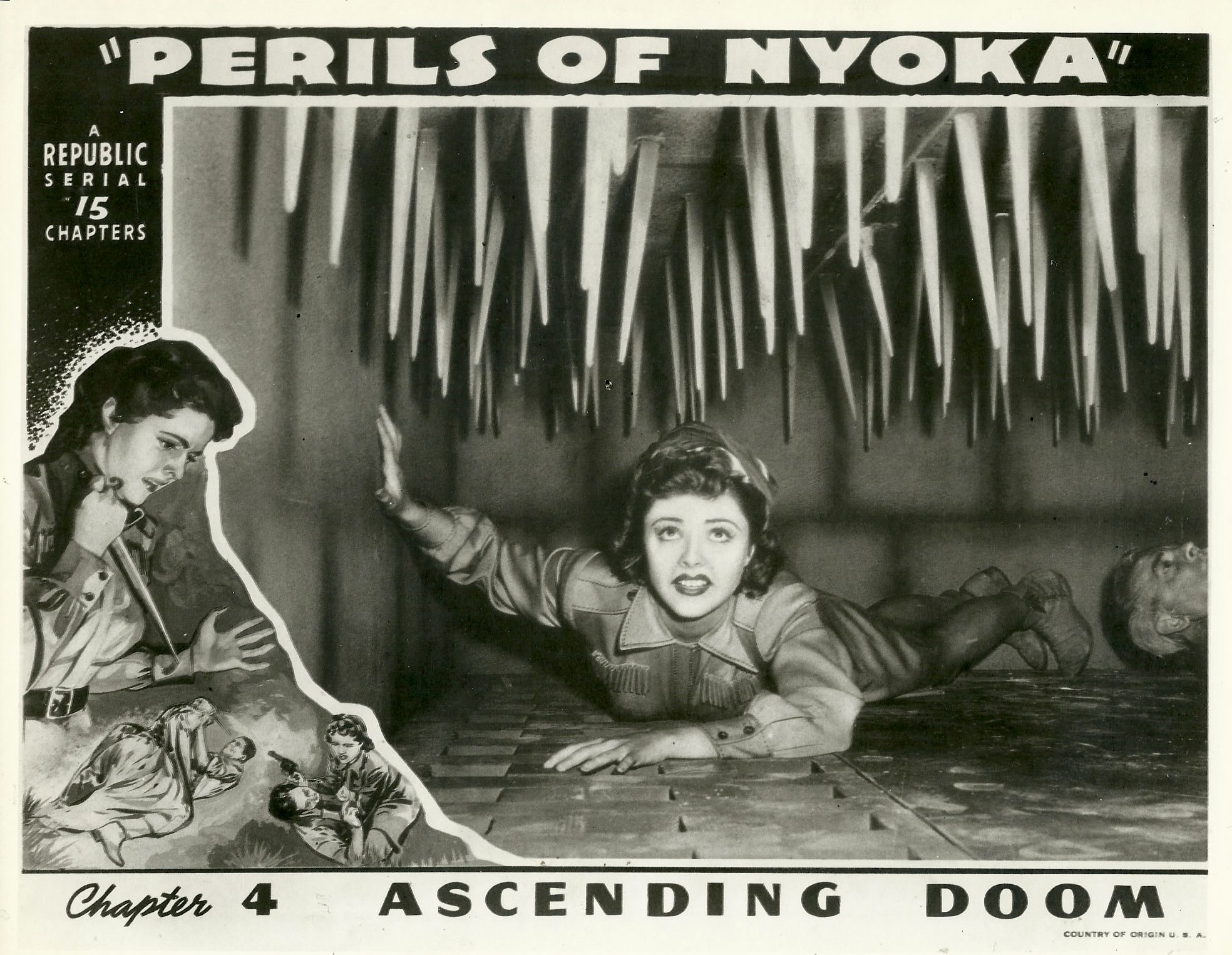 ★★★½
★★★½
“Serial thriller.”
After the success of Jungle Girl, Republic looked to repeat the process the following year. However, despite bringing back the heroine, they were able to avoid paying Edgar Rice Burroughs again, because Nyoka was not a character who appeared in the original novel. It may also be why she has a different surname here, and her father is missing, rather than killed. Republic used a different actress too: Kay Aldridge replaced Frances Gifford, who was unavailable. Aldridge had recently seen her contract with 20th Century Fox expire, though had some qualms: “I did it with the attitude we had in that day that to make a B-western or a serial was a comedown for a featured player at Fox. It was a comedown in one way, but it was a comeup in another way because I was the lead. They paid me about $650 a week, which was pretty good money at the time.” Still, it proved her most popular role, though she retired from acting just four years later, to get married.
With a title clearly nodding to 1914’s The Perils of Pauline, this operates at a particularly breathless rush, even by serial standards, over its 15 episodes. The main plot has Nyoka Gordon in search of the Tablets of Hippocrates, both because they offer a cure for cancer, but in order to help find her father, who vanished mysteriously in the African wilderness years previously. Well, I say “African”. There’s really no effort at all made to make Southern California look like anything other than Southern California. Anyway, she’s joined in her quest by Dr. Larry Grayson (Moore, best known as TV’s Lone Ranger) and other scientists, but opposed by the evil Vultura (Gray) and her native minions, who wants the tablets for herself. Actually, from a modern perspective, Vultura probably has more of a claim to the artifacts than the tomb-raiding Westerners, Nyoka’s protestations about them belonging to “humanity” notwithstanding.
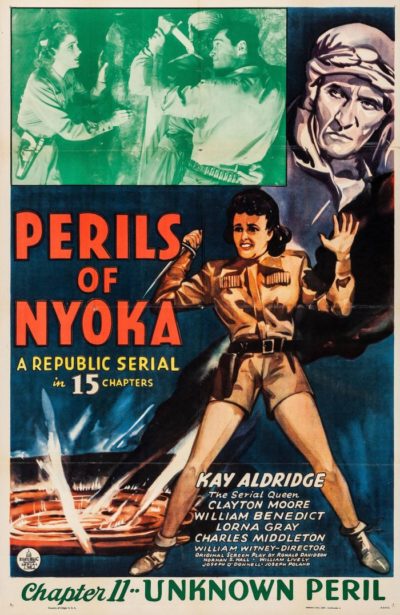 This was the first serial I had watched since Zorro’s Black Whip, and I really appreciated the relentless pace with which things moved forward. There’s literally never a dull moment, despite the usual overlap: opening of each episode recaps the previous cliffhanger, then details how (usually) Nyoka gets out of the peril in question. These escapes were a bit varying in quality: some of them were clever, others were more or less cheats, e.g. falling from a great height into a pool of water that wasn’t there previously.
This was the first serial I had watched since Zorro’s Black Whip, and I really appreciated the relentless pace with which things moved forward. There’s literally never a dull moment, despite the usual overlap: opening of each episode recaps the previous cliffhanger, then details how (usually) Nyoka gets out of the peril in question. These escapes were a bit varying in quality: some of them were clever, others were more or less cheats, e.g. falling from a great height into a pool of water that wasn’t there previously.
But the show never gives pause to consider such things, moving on to the next treachery, chase or fight sequence. Of particular note is the antagonist also being a woman, and Vultura is every bit as smart, driven and hands-on as Nyoka. There’s potentially an alternative version of this where she is the heroine. It’s definitely an improvement on the “ignorant savages” portrayed in Jungle Girl. Indeed, Nyoka v2.0 is also a clear upgrade on the original, being much more self-reliant, certainly the equal of the men.
Admittedly, the pace is maintained at the expense of just about everything else. When you have perhaps 15 minutes in which to cram a recap, escape, move the plot forward and then set up the next cliffhanger… there’s never going to be much chance to get in a lot of character development. Everybody here is more or less what they appear in episode one, and there’s hardly anything in the way of an arc for anyone across the four hours. Hard to complain though, since it is for understandable reasons. What matters here is not any backstory, it’s a simple matter of hooking the audience into coming back the following Saturday for the next episode. Having shotgunned as many as five episodes back-to-back, I can’t argue with its success on that front.
I also feel I should mention the animals. Fang, Nyoka’s dog, is perhaps the smartest canine I’ve ever seen on a show: to be honest, he’s more intelligent than some of the human characters, and does a remarkable amount, especially considering his lack of opposable thumbs. There’s also a little monkey, belonging to one of her sidekicks, who chips in, while Vultura keeps a pet gorilla. That, however, is a guy in a not particularly convincing suit. Though considering it gets into fisticuffs with Dr. Grayson, I can understand why they didn’t want to use a real primate for that! Their cute presence do make me wonder if this was aimed as much as kids as adults. Though given the amount of violence – there are corpses everywhere, albeit bloodless ones – it feels a little inappropriate for children by modern standards.
The show proved popular enough to be re-released a decade later, under the rather confusing title, Nyoka and the Tigermen. A few years further down the road, it was converted into a 100-minute TV movie, Nyoka and the Lost Secrets of Hippocrates. Normally, hacking out such a large amount of content would render any cinematic product incoherent. But I can see how it would be possible here, though I dread to think how adrenaline-crazed that end product might be!
Dir: Bill Witney
Star: Kay Aldridge, Clayton Moore, Lorna Gray, Charles Middleton
The Tiger Woman
By Jim McLennan★★½
“A leopard which changes its spots.”
Am I the only person irrationally annoyed by the title of this 12-episode serial? It takes place in South America, where the only tigers are in captivity. And look at the picture of the heroine. LOOK AT IT. In what universe is that a tiger? I mean, the ears are a nice touch, but it’s very obviously not tiger stripes. Though it has been pointed that in its location, the jaguar is known as el tigre. Which might make sense if there was any other jot of Hispanic culture to be found here. [GWG readers: “Get on with it!”] Oh, alright… if you insist.
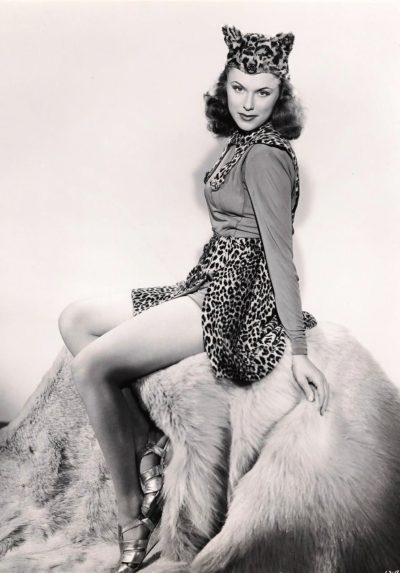 As mentioned, we’re in South America, where two competing oil companies are seeking to establish their territory. The Inter Ocean Oil Company are the current occupants, and have been working in association with the indigenous population, under their white queen (Stirling), known as the Tiger Woman. But if they don’t strike oil soon, their franchise will expire. A predatory, far less friendly (but unnamed) company, is standing by, to make sure that doesn’t happen, allowing them to take over. But Inter Ocean has sent top troubleshooter, Allen Saunders (Rock Lane), to work with the Tiger Queen and block their enemy’s attempts. Those get more desperate as the deadline approaches and Inter Ocean appear to be succeeding. Complicating matters is the Tiger Queen’s original identity as missing heiress, Rita Arnold, something her enemies want to use to their advantage.
As mentioned, we’re in South America, where two competing oil companies are seeking to establish their territory. The Inter Ocean Oil Company are the current occupants, and have been working in association with the indigenous population, under their white queen (Stirling), known as the Tiger Woman. But if they don’t strike oil soon, their franchise will expire. A predatory, far less friendly (but unnamed) company, is standing by, to make sure that doesn’t happen, allowing them to take over. But Inter Ocean has sent top troubleshooter, Allen Saunders (Rock Lane), to work with the Tiger Queen and block their enemy’s attempts. Those get more desperate as the deadline approaches and Inter Ocean appear to be succeeding. Complicating matters is the Tiger Queen’s original identity as missing heiress, Rita Arnold, something her enemies want to use to their advantage.
The heroine is something of a step forward from Jungle Girl, with Rita/Ms. Tiger at least making an occasional effort to get involved in the fisticuffs (copious, to the point half the oil company’s profits must have gone on replacement furniture). However, it’s rare for this to last more than a few seconds, and it seems she’s as fragile as cut crystal. Run into a wall? Knocked out. Trip on the carpet? Knocked out. Looked at askance by a bad guy? Probably knocked out. I swear, there are times where it feels like she spends half her screen time unconscious.However, as in Jungle Girl, there are odd moments which rise above, though I’m not sure the aeroplane spin would be a move familiar to white goddesses from the sky.
She does have a regal presence (perhaps due to Sterling’s background as a model, before she turned to acting), even if her throne looks a bit like it was built out of banana boxes. Ms. Tiger is also reasonably brave, always willing to put herself in danger when necessary for her tribe – or, probably more relevantly, necessary for cliff-hanger purposes. I was less impressed with the plotting, especially the shenanigans of the villains, which seem almost random, rather than well-conceived to their particular aims. For instance, they’re supposed to kill Rita, then get someone else to impersonate her and claim the inheritance. If that’s the best plan you can come up with… you need to bring in some kind of outside consultant. Again, it feels as if everything they do is for cliff-hanger purposes, not as a means to an end. It gets kinda repetitive after a while.
Still, this was a big hit, and led to Republic fast-tracking another vehicle for Sterling. Only a few months after this was released, production started on Zorro’s Black Whip, in which she would get to be more of a proper lead.
Dir: Spencer Bennet and Wallace Grissell
Star: Linda Stirling, Allan Lane, Duncan Renaldo, George J. Lewis
Subsequently re-released in 1951 as Perils of the Darkest Jungle, and in a cut-down TV version in 1966 as Jungle Gold.
Zorro’s Black Whip
By Jim McLennan★★★
“Masked woman with a whip? Despite being almost 70 years old, still better than Catwoman.”
 This 12-part serial from Republic was a spin-off from the success of Zorro – though despite the title, the Z-word is never mentioned. It moves the legend from Spanish California to Idaho in the 1880’s, just before a vote to decide whether it would become a state. Villainous Dan Hammond (McDonald) begins a violent campaign to prevent this, and is opposed by local newspaper owner Randolph Meredith, who has a secret identity as The Black Whip, a masked vigilante. When he is shot dead, his sister Barbara (Stirling) takes up the cape and whip, along with the help of undercover federal agent, Vic Gordon (Lewis). Together, they foil Hammond’s increasingly-desperate plots as voting day nears, and escape from 11 precarious positions. Well, it is a serial, after all…
This 12-part serial from Republic was a spin-off from the success of Zorro – though despite the title, the Z-word is never mentioned. It moves the legend from Spanish California to Idaho in the 1880’s, just before a vote to decide whether it would become a state. Villainous Dan Hammond (McDonald) begins a violent campaign to prevent this, and is opposed by local newspaper owner Randolph Meredith, who has a secret identity as The Black Whip, a masked vigilante. When he is shot dead, his sister Barbara (Stirling) takes up the cape and whip, along with the help of undercover federal agent, Vic Gordon (Lewis). Together, they foil Hammond’s increasingly-desperate plots as voting day nears, and escape from 11 precarious positions. Well, it is a serial, after all…
Within the harsh limitations of the format, it does its best. In less than 15 minutes per episode, they have to fit in opening credits, a recap, replay the previous cliff-hanger, resolve that, set up the next cliff-hanger and finish with the closing credits. It leaves precious little time for plot or character development, which may explain why all the bad guys wear black hats. Seriously. They could reduce crime by 90% simply by banning the sale of non-white headgear, or so it would appear. Vic does most of the heavy lifting, action-wise, brawling frequently; Barbara generally stands back and uses her whip, which makes sense. Though, to be honest, the villains are remarkably oblivious to the Whip’s feminine curves: they’re blinded by their own sexism, at one point rejecting a suggestion Babs is the masked marauder, saying, “She couldn’t be! The Black Whip’s got to be a man!”
While clunky, sporting a dreadful ending for Hammond, and truly a product of its time (1944), the action is frequent and competent, thanks to the second-unit work of the legendary stuntman Yakima Canutt, who was the inspiration for much of John Wayne’s on-screen persona, and is best-known for staging the chariot-race in Ben Hur. The horse-work here is still outstanding: Babe DeFreest was the double for Stirling, and can be seen riding with her here. You could edit this down into a somewhat hyper feature, which would still be complete nonsense, yet given its age, is far from unwatchable.
Dir: Spencer Bennet and Wallace Grissell
Star: Linda Stirling, George J. Lewis, Francis McDonald, Hal Taliaferro
The Black Widow
By Jim McLennan★★½
“Stay here. And make me a sandwich!”
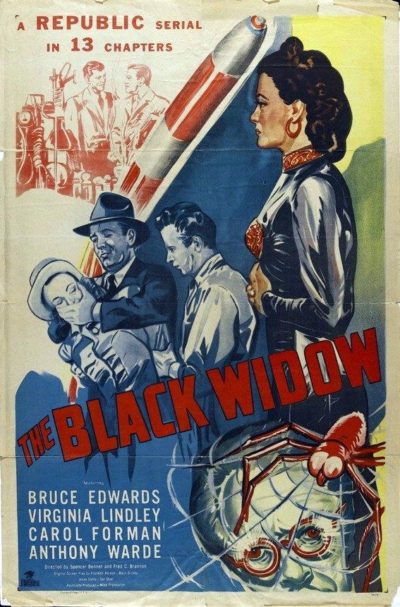 This is something of a fringe entry, and illustrates a few of the issues with Hollywood of the time. In particular, a severe reluctance to let female characters act with genuine independence. We see this on both side of the story here. The title character is Sombra (Forman), a vaguely Asiatic woman who is engaged in a plot to steal nuclear secrets from the United States. To this end, she has been trying to bribe acquaintances of a notable scientist, but the trail of spider-envenomed corpses resulting from their refusal to help has brought her to the attention of the Daily Clarion and its ace girl reporter, Joyce Winters (Lindley). Which would be fine, if the women were allowed to go head-to-head on their own terms, in the same way as Perils of Nyoka.
This is something of a fringe entry, and illustrates a few of the issues with Hollywood of the time. In particular, a severe reluctance to let female characters act with genuine independence. We see this on both side of the story here. The title character is Sombra (Forman), a vaguely Asiatic woman who is engaged in a plot to steal nuclear secrets from the United States. To this end, she has been trying to bribe acquaintances of a notable scientist, but the trail of spider-envenomed corpses resulting from their refusal to help has brought her to the attention of the Daily Clarion and its ace girl reporter, Joyce Winters (Lindley). Which would be fine, if the women were allowed to go head-to-head on their own terms, in the same way as Perils of Nyoka.
Except, neither of them are. Sombra is basically a puppet of her father, King Hitomu, who pops up through a cloud of smoke in a teleportation device, to keep her in line and hand down decrees that must be obeyed. Worse, the newspaper calls in Steve Colt (Edwards), a hard-boiled crime fiction author, to take lead in their investigation. He truly treats Joyce like crap, repeatedly ordering her to stay behind and refusing to let her drive. This unrepentant chauvinist even handcuffs her to the car at one point, to stop her following. Fortunately for him, Joyce is resourceful enough to unbolt herself, and so is able to stop Steve from being gunned down by Sombra’s minions. His gratitude for saving his life is… largely notable by its absence.
In between the blatant sexism, which definitely hampers things, there are some cool elements. I particularly liked the way Sombra is a woman of a thousand faces, able to disguise herself as any other woman perfectly. So we get some scenes where we have Lindley playing Forman as Sombra, pretending to be Joyce, if you see what I mean. It’s fun. There is a fair amount of technobabble here e.g. a sonic disruption device, but occasionally the script does hit on something a little prophetic, e.g. the tracking device Steve uses to locate Sombra’s lair. Though it is rather larger than the modern equivalent, shall we say! I’m also a little concerned about the ease with which he is allowed to gun down unarmed civilians, and his lack of remorse thereof.
I did like the performances of both Lindley and Forman, though one aspect of the latter is a “Yellow Peril”-like portrayal that hasn’t aged well. But as is often the case, being a villainess does give you a bit more independence, and Sombra is clearly the boss when her father isn’t around. However, if you’re not throwing things at the screen when Steve gets all “No, you’re not coming with me, little lady,” then you’re probably on the wrong website. I was wishing throughout for him to have a close encounter of the poisonous kind with Sombra’s arachnid pals.
Dir: Spencer Gordon Bennet and Fred C. Brannon
Star: Bruce Edwards, Virginia Lindley, Carol Forman, Anthony Warde
Daughter of Don Q
By Jim McLennan★★★
“No relation to Maggie, presumably.”
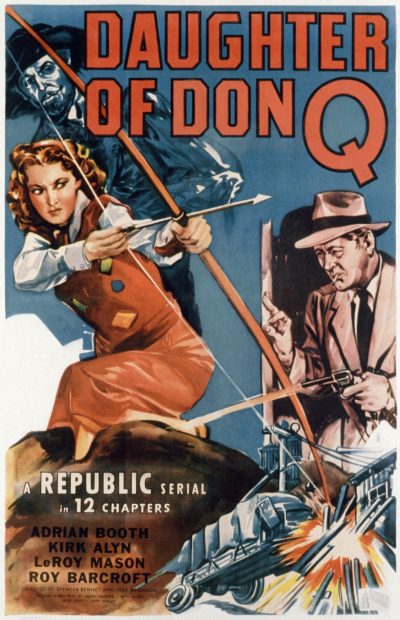 Lorna Gray, the lead here, had been the villainess in Perils of Nyoka, but graduates to the role of protagonist. This is notable for its contemporary, urban setting, without any of the “jungle girl” trappings of previous Republic serials. Heroine Dolores Quantero (Gray, although now billed as Adrian Booth) is a thoroughly modern woman, who happens to be proficient at jiu-jitsu, and also no mean hand with a longbow. The former is of rather more importance than the latter, which only really crops up during one episode. Perhaps this feistiness is genetic, since Dolores is a descendant of Don Quantero, a heroic historical figure [the title of this may be a nod to 1925 silent film, Don Q, Son of Zorro, starring Douglas Fairbanks].
Lorna Gray, the lead here, had been the villainess in Perils of Nyoka, but graduates to the role of protagonist. This is notable for its contemporary, urban setting, without any of the “jungle girl” trappings of previous Republic serials. Heroine Dolores Quantero (Gray, although now billed as Adrian Booth) is a thoroughly modern woman, who happens to be proficient at jiu-jitsu, and also no mean hand with a longbow. The former is of rather more importance than the latter, which only really crops up during one episode. Perhaps this feistiness is genetic, since Dolores is a descendant of Don Quantero, a heroic historical figure [the title of this may be a nod to 1925 silent film, Don Q, Son of Zorro, starring Douglas Fairbanks].
Another member of the family, Carlos Manning (Mason) becomes aware of a land grant given to their ancestor by the Spanish crown, which will allow him to claim ownership of large tracts of property. However, the rights would be divided among all the Don’s descendants, so Carlos decides to start bumping off other family members. The process begins with the attempted theft of a heirloom from Dolores’s house which details the Quintero genealogy. This alerts her to the plan, and along with journalist Cliff Roberts (Alyn), she looks to protect her relatives and get to the bottom of Carlos’s scheme, dodging retaliatory efforts to lop her off the family tree.
While I liked the modern scenario, it’s a bit of a mixed bag, both in terms of story and in Dolores’s character. Even by the low standards of serial villainy, Carlos’s plans seem both ridiculous and ill-conceived. I was particularly unimpressed by the attempt to have Dolores shot with a harpoon gun while dangling in a net, apparently because it would look like a “vendetta killing.” Yeah, between two gangs of whales. The serial even seems to have a bottle episode consisting largely of footage taken from previous parts, with the heroine and hero describing their previous brushes with death. Considering there are only 12 chapters to begin with, this recycling of previous peril is disappointing, as is the apparent inclusion of action footage from earlier serials, such as The Masked Marvel.
However, some of the more imaginative elements do work, such as Dolores going undercover as the target in a knife-throwing act, and some of the supporting characters are surprisingly memorable. That the heroine knows and uses martial arts may also be close to a first for Hollywood, even if it’s a few basic throws at most. Despite this, she does still have a tendency to fall unconscious too easily, and sit back when things kick off – though we’ll give her the benefit of the doubt for the fight where she takes a chair to the face! While overall entertaining, the finale is particularly disappointing in terms of her passivity, with Cliff speeding to her rescue, as the crate she’s tied up in, is about to be thrown off a high bridge. I’d rather she had rescued him, or at least herself. I guess jiu-jitsu and archery was as far as Republic were willing to go, in the way of female empowerment.
Dir: Spencer Gordon Bennet and Fred C. Brannon
Star: Lorna Gray (as Adrian Booth), Kirk Alyn, LeRoy Mason, Roy Barcroft




